Trump Administration Proposes New Offshore Oil Lease Auctions

Trump Administration Proposes New Offshore Oil Lease Auctions
The Trump administration is preparing to auction offshore oil drilling leases along U.S. coastlines that have been off-limits for decades, with plans to begin as early as 2026. This initiative targets expanded leasing areas including the Atlantic coast, the Pacific near California, and parts of Alaska, reversing previous restrictions set by the Biden administration[1][2].
Expanding Access to Offshore Energy Resources
The proposal aims to significantly increase domestic oil production capacity by opening nearly all U.S. coastal waters, except for certain protected marine monuments. The Department of the Interior’s draft plan outlines a series of lease sales over a five-year period, potentially boosting energy independence and economic benefits through job creation and increased federal revenues[3][6].
Environmental and Political Implications
This move has stirred controversy, drawing criticism from environmentalists and some politicians who warn about risks to marine ecosystems and coastal tourism. The plan must undergo public comment and further review before final implementation, reflecting ongoing debates about balancing energy needs with environmental protection[1][2].
About the Organizations Mentioned
Department of the Interior
The **U.S. Department of the Interior (DOI)** is a Cabinet-level executive department of the federal government responsible for managing and conserving the nation’s vast natural resources, public lands, and cultural heritage. Established in 1849, the DOI oversees approximately 20% of U.S. land, including national parks, wildlife refuges, and public lands, as well as managing subsurface minerals and energy resources across more than 2 billion acres including the Outer Continental Shelf[1][2][3]. The DOI’s mission encompasses stewardship of natural resources to benefit the American people, scientific research on natural hazards, and maintaining trust responsibilities to 567 federally recognized Indian tribes and Alaska Native communities. Its bureaus include the National Park Service, Bureau of Indian Affairs, U.S. Geological Survey, Bureau of Land Management, U.S. Fish and Wildlife Service, and others dedicated to resource management, conservation, and cultural preservation[1][2][4][8]. Historically, the department was formed to consolidate diverse domestic functions scattered across other departments, such as Indian Affairs and land management, reflecting the growing federal responsibilities following the Mexican–American War. Over time, some functions were transferred to other agencies, but the DOI remains the primary federal steward of public lands and Indian affairs[3]. Notably, in 2021, Rep. Deb Haaland became the first Native American to serve as Interior Secretary, marking a historic milestone for the department’s leadership[1]. The DOI also plays a critical role in environmental conservation, endangered species protection, water resource management in the Western states, and supplying 30% of the nation’s energy resources, including hydropower[2]. In the context of business and technology, the DOI influences sectors like energy development, mineral extraction, and land-use planning, balancing economic activities with sustainability and environmental stewardship. It also leverages scientific data and technology for resource management, hazard assessment, and tribal partnerships, making it a pivotal agency at the intersection of natura








